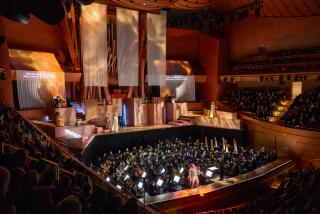Review: An unforgettable trip through L.A. from its ‘Ambassador’
To borrow the title from Thom Anderson’s cult classic documentary film, Los Angeles plays itself in Gabriel Kahane’s “The Ambassador,” and the performance is vibrant, melancholy and seductive.
An elegant musical journey over the landscape and emotionally encoded architecture of L.A. as myth and place, “The Ambassador” was one of last year’s more potent yet unclassifiable recordings.
Multi-talent Kahane, classically trained and almost ridiculously deft in finding new pathways between contemporary musical thought, art pop, folk and a new vision of musical theater, has taken the theatrical version “The Ambassador” to a fresh place.
ESSENTIAL ARTS & CULTURE NEWSLETTER >> Get great stories delivered to your inbox
Conceived and staged by director John Tiffany and Kahane, it was premiered at Brooklyn Academy of Music AM in December and given its West Coast premiere at UCLA’s Freud Playhouse over the weekend as part of its CAP-UCLA series.
The local performance was a homecoming, with a caveat: Kahane, son of longtime Los Angeles Chamber Orchestra conductor Jeffrey Kahane, lived in L.A. for only the first two years of his life. But he has channeled an obvious and obsessive intrigue with the city.
Anderson’s film was part of myriad influences on Kahane’s sweeping song cycle, along with the movie “Blade Runner” and literary sources including the noir fiction of James M. Cain and Raymond Chandler.
Most integrally and creatively, though, Kahane’s piece is built around fondly regarded landmarks of historic L.A. architecture and other key sites, from the now-defunct Ambassador Hotel, site of Robert F. Kennedy’s assassination, to the Bradbury Building, Union Station and Musso and Frank.
Also figuring into the scenario are Modernist monuments of Schindler (the historic King’s Road house, where, fittingly, experimental music concerts have been held) and Richard Neutra, as well as the Empire Liquor Mart in south central L.A., where 15-year-old Latasha Harlins was killed in 1991.
His 10-minute mini-epic, from the perspective of the young victim, is a reality check and power spot in the show, a cold street level respite from Hollywood fodder and socio-cultural observations.
At UCLA, the stage set was packed with stacks of books, like precarious literary cairns or metaphorical stand-ins for skyscrapers on the cityscape. The unassuming and bearded but quietly charismatic Kahane, first cradling a small cardboard cutout of himself before leaping into the musical flow, moved fluidly from piano to guitar and between vintage cultural technologies, reel to reel, VHS, slide projector and vinyl.
Aided by his ace seven-piece electro-acoustic, rock chamber ensemble (basically, a rock band meets string trio), “The Ambassador” navigated intricate colorful arrangements and complemented the pure-toned singer’s nimble delivery.
INTERACTIVE: Guide to L.A. landmarks in ‘The Ambassador’
Each song came equipped with its own staging scheme, from edgy roaming searchlights to a sequence of songs about L.A.’s link to Modernist architecture. The evening’s one cover song was a choice and suitable one — Jerome Kern’s “The Folks Who Live on the Hill,” and Kahane’s hilarious “Villains,” posed and expanded upon the wry musical question “Why do villains always live in houses built by Modernist masters?”
Staging and visuals aside, imagery and loaded sense of place hum and bustle through the purely musical and lyrical content of Kahane’s piece, along with Kahane’s unique take on a new brand of pop art song. There are echoes of musicians with varying connections to theater and theatrical frameworks, including fellow conceptualist Sufjan Stevens, Paul Simon, the internal logic and surprising turns of Stephen Sondheim, as well as Randy Newman and Kurt Weill.
But Kahane, whose previous work includes the cheeky song cycle “Craigslistlieder,” is onto a special terrain. By the time the show eased into the wistful finale of Kahane’s bittersweet ode to Union Station — “in the hall ... of the lost,” he intones in a repeating, sad hymn-like refrain — the stage of the overall work had been both set and fulfilled, informed by the meaning and melancholy of these insightful songs about buildings.
Kahane understands the point that buildings have feelings too, not to mention complicated ghost stories.
More to Read
The biggest entertainment stories
Get our big stories about Hollywood, film, television, music, arts, culture and more right in your inbox as soon as they publish.
You may occasionally receive promotional content from the Los Angeles Times.






